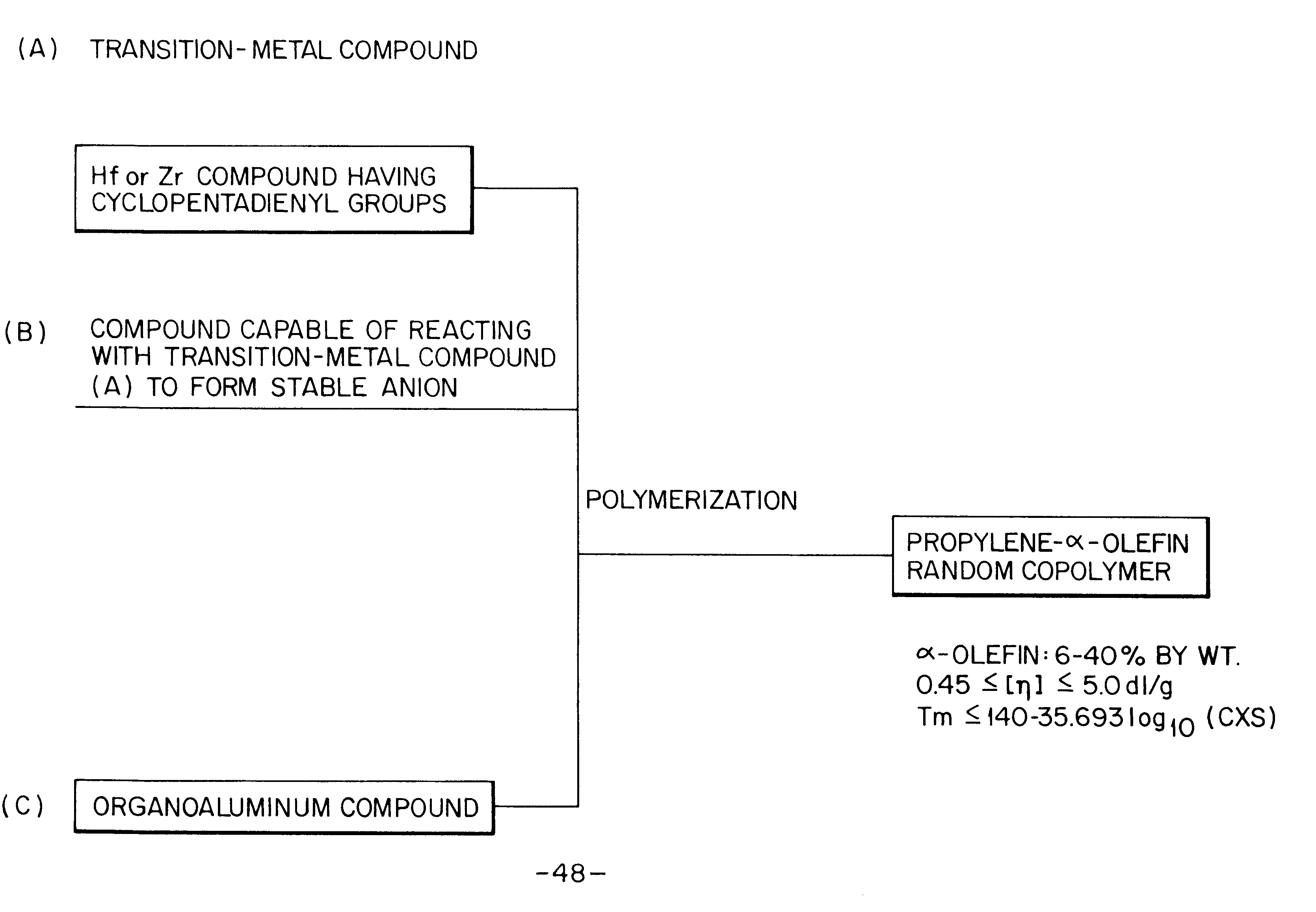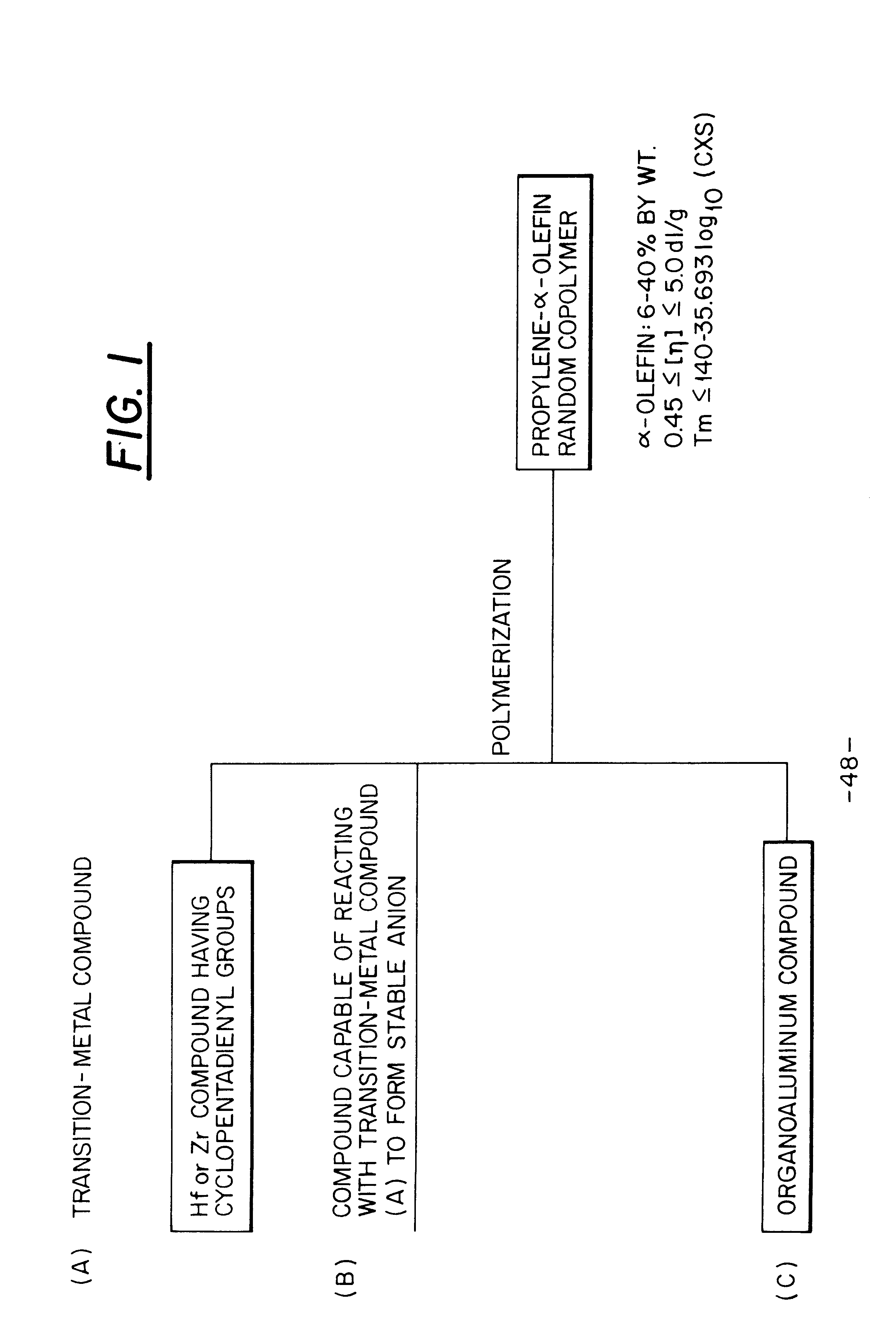Propylene random copolymer and film laminate thereof
- Summary
- Abstract
- Description
- Claims
- Application Information
AI Technical Summary
Benefits of technology
Problems solved by technology
Method used
Image
Examples
example 1
A 1-liter stainless steel autoclave equipped with stirrer was purged with nitrogen gas. Twenty-eight grams of liquified 1-butene and 252 grams of liquified propylene were introduced into the autoclave, and the autoclave was cooled to a polymerization temperature of 0.degree. C.
A 100 mL flask with a magnetic stirrer was also purged with nitrogen gas. In an atmosphere of nitrogen, 10 mL of toluene that was purified with activated alumina, 3.5 mmol of triethylaluminum, and 5.6 .mu.mol of ethylenebis(indenyl)zirconium dichloride were mixed with stirring for five minutes at ambient temperature. The mixture was then introduced into the 1 liter autoclave described above. After a solution of 5.6 .mu.mol trityltetrakis(pentafluorophenyl) borate dissolved in 5 mL of toluene was further introduced into the autoclave, the autoclave was kept at 0.degree. C. for 0.7 hours for polymerization. The polymerization was stopped by injection of 10 mL of isobutyl alcohol with stirring for a...
example 2
Except that 56 grams of liquified 1-butene and 224 grams of liquified propylene were used for polymerization and that the polymerization time was 1.5 hours, the procedures of Example 1 were repeated for Example 2 to yield 23 grams of a propylene-1-butene copolymer. The content of 1-butene in the copolymer obtained was measured to be 18.9% by weight. The melting point and the intrinsic viscosity [.eta.] were respectively equal to 119.degree. C. and 0.57 dl / g. The heat-sealing temperature of a film having a sealant layer prepared from the copolymer was 101.degree. C. prior to corona discharge treatment and 104.degree. C. after corona discharge treatment. The blocking resistance was 0.27 kg / 12 cm.sup.2, and the total haze was 1.3%. The results of the evaluation are shown in Table 1.
example 3
Except that 84 grams of liquified 1-butene and 190 grams of liquified propylene were used for polymerization and that the polymerization time was 1.5 hours, the procedures of Example 1 were repeated for Example 3 to yield 31 grams of a propylene-1-butene copolymer. The content of 1-butene in the copolymer obtained was 25.2% by weight. The melting point and the intrinsic viscosity [.eta.] were respectively 108.degree. C. and 0.55 dl / g. The heat-sealing temperature of a film having a sealant layer prepared from the copolymer was 89.degree. C. prior to corona discharge treatment and 91.degree. C. after corona discharge treatment. The blocking resistance was 0.50 kg / 12 cm.sup.2, and the total haze was 0.9%. The results of the evaluation are shown in Table 1.
PUM
| Property | Measurement | Unit |
|---|---|---|
| Temperature | aaaaa | aaaaa |
| Temperature | aaaaa | aaaaa |
| Fraction | aaaaa | aaaaa |
Abstract
Description
Claims
Application Information
 Login to View More
Login to View More - R&D
- Intellectual Property
- Life Sciences
- Materials
- Tech Scout
- Unparalleled Data Quality
- Higher Quality Content
- 60% Fewer Hallucinations
Browse by: Latest US Patents, China's latest patents, Technical Efficacy Thesaurus, Application Domain, Technology Topic, Popular Technical Reports.
© 2025 PatSnap. All rights reserved.Legal|Privacy policy|Modern Slavery Act Transparency Statement|Sitemap|About US| Contact US: help@patsnap.com


